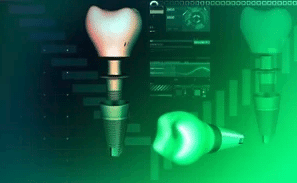 As you prepare for your dental implant surgery, you may wonder how this surgical procedure has evolved to achieve more predictable results with less discomfort for you. You’ll want to choose a dental surgeon that can provide cutting-edge care for the best results possible. Why not choose a surgeon that has developed the most advanced and accurate implant placement system in the world?
As you prepare for your dental implant surgery, you may wonder how this surgical procedure has evolved to achieve more predictable results with less discomfort for you. You’ll want to choose a dental surgeon that can provide cutting-edge care for the best results possible. Why not choose a surgeon that has developed the most advanced and accurate implant placement system in the world?
Recent developments in dental implant surgery are exciting—for surgeons and patients alike. In particular, implant placement developments have helped improve the esthetics and function of dental implants, which rely heavily on accurate placement. This is now possible with less discomfort and fewer visits to the doctor.
Surgeons have the ability to plan your surgery ahead of time with more accuracy, using CBCT’s. They can use these images to “guide” their hands and instrument during surgery. This is called “Image Guided Surgery”. Image guided surgery allows the surgeon to be more accurate and make smaller incisions. Smaller incisions mean less pain after surgery. Higher accuracy mean less time and expense for your dentist.
Presently, more than 90% of dental implants are placed “freehand” with large margins of error. These doctors do not use any form of image guided surgery.
Dental implants need to be placed at the proper position, depth, and angle so that your bite is aligned correctly and the surrounding teeth are not crowded. The cutting-edge technology used by dynamic navigation, The X-Guide, provides the highest level of accuracy.
How the Revolution Began:
Computer-aided Surgery with Static Guides
Computer-aided design and manufacturing (CAD/CAM) revolutionized the process of dental implant placement. Static navigation takes advantage of computed tomography (CT) data to generate static guides for implant placement. The guides control the depth and angle of placement during surgery. These guides are called “static guides.” They are more accurate than freehand dental implant placement.
Advantages and Disadvantages of Static Guides
The main advantage of static guides is that they are more accurate than freehand dental implant placement. The main problem with static navigation is that your doctor’s plan cannot be changed during the procedure. Very often your surgeon needs to alter your original plan to perfect the plan for your mouth. Your doctors would need to abandon their pre-fabricated “static” guide and proceed freehand. We know that freehand equals less accuracy.
Static placement is also costly and time consuming. Producing the imaging guide requires lab work that can take up to 2 weeks. The pre-operative procedures needed to make the scans add to the overall cost of the procedure. The increase preparation time, cost, and inflexibility has limited the use of static guides.
State-of-the-art Placement with Dynamic Navigation
Dynamic 3D Navigation is like a GPS for your dental surgeon. Think of Google Maps on your phone. The system uses your dentist’s CBCT and intraoral scanner equipment to make a map of your mouth that is then used like a GPS map to guide your surgeon’s hand during implant placement.
Dynamic navigation provides superior accuracy, at the micron level, while also avoiding the disadvantages of static navigation. With dynamic navigation, the surgical plan is developed before surgery and can be changed during the surgery if needed. Your surgeon is more accurate and can use small incisions which means less pain.
To summarize, after the preliminary scan, your surgeon uses a navigation screen to guide placement of your implant. Like a GPS, the X-Guide provides turn-by-turn guidance for your surgeon’s handpiece during surgery. Your surgeon does not need to see directly into your mouth, so this procedure can be carried out on patients who have trouble opening their mouths wide.
Benefit from Pin-point Accuracy
The scan improves placement accuracy for a more successful and esthetically-pleasing result. Studies cited in Drs. Block and Emery’s article, Static or Dynamic Navigation for Implant Placement—Choosing the Method of Guidance, have shown that the margins of error for entry are about 0.4 mm and 4o for angle of placement, a dramatic improvement over freehand placement. Today the majority of doctors place implant the old fashion way: freehand!
As you prepare for dental implant surgery, you’ll want to discuss the latest developments in placement techniques to see if you can take advantage of dynamic navigation. When your dental surgeon chooses The X-Guide, Dynamic 3D Navigation, you benefit from the result of 230 cumulative years of medical and dental product experience. You benefit from increase accuracy, smaller incisions and less pain.
At CCOMFS, you have the added advantage of the expertise of Dr. Robert W. Emery, one of the inventors of X-Guide Dynamic 3D Navigation.
Join the revolution in dental implant placement by scheduling your consultation with Dr. Emery today.